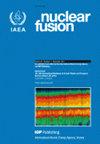High performance power handling in the absence of an H-mode edge in negative triangularity DIII-D plasmas
IF 4
1区 物理与天体物理
Q1 PHYSICS, FLUIDS & PLASMAS
引用次数: 0
Abstract
Experiments performed during strongly-shaped high-power diverted negative triangularity (NT) experiments in DIII-D achieved detached divertor conditions and a transient-free edge, showcasing the potential for application of NT to a core-edge integrated reactor-like scenario and providing the first characterization of the parametric dependencies for detachment onset. Detached divertor conditions will be required in future devices to mitigate divertor heat fluxes. Access to dissipative divertor conditions was investigated via an increase in upstream density. Detachment onset at the outer strike point was achieved with H-mode level confinement and reactor-relevant normalized pressures . Confinement degradation was observed with deeper detachment, associated with the loss of an electron temperature pedestal. Differences in geometry, radial transport, impact of cross field drifts are discussed to explain differences in access to detachment in NT discharges. Higher normalized densities, with respect to equivalent discharges in positive triangularity, were necessary to achieve detachment, partially explained by the shorter parallel connection length to the targets. The effect of cross-field particle drifts (E×B, B B) on access to detachment was demonstrated by the lower upstream density needed to access detachment with ion B B drift directed outside of the active divertor (Greenwald fraction 0.9–1.0 vs 1.3). The upstream density at detachment onset was observed to increase linearly with plasma current with ion B B drift into the divertor, consistent with the observed narrowing of the scrape-off layer heat flux width λq. Edge fluid simulations capture separatrix densities needed to achieve detachment in NT plasma and their dependence on drift direction. The ability to reproduce detachment dynamics in NT plasma increases the confidence in future design studies for NT divertors.负三角形 DIII-D 等离子体中无 H 模式边缘时的高性能功率处理
在 DIII-D 强形高功率分流负三角形(NT)实验中进行的实验实现了脱离岔道条件和无瞬态边缘,展示了将 NT 应用于类似堆芯边缘集成反应堆方案的潜力,并首次描述了脱离开始的参数依赖性。未来的装置将需要分离岔流条件,以减轻岔流热通量。通过增加上游密度,对进入耗散岔流条件进行了研究。外侧撞击点的脱离是在 H 模式水平约束和反应堆相关归一化压力下实现的。在更深的脱离过程中观察到了与电子温度基座丧失有关的约束退化。讨论了几何形状的差异、径向传输、交叉场漂移的影响,以解释 NT 放电中脱离通道的差异。与正三角形的等效放电相比,需要更高的归一化密度才能实现脱离,与目标的平行连接长度较短是部分原因。跨场粒子漂移(E×B、B B)对脱离的影响表现在,离子 B B 漂移指向主动分流器外时,脱离所需的上游密度较低(格林沃德分数 0.9-1.0 与 1.3)。观察到脱离开始时的上游密度随离子 B B 漂移进入分流器时等离子体电流的增加而线性增加,这与观察到的刮离层热通量宽度 λq 变窄一致。边缘流体模拟捕捉了在 NT 等离子体中实现脱离所需的分离矩阵密度及其对漂移方向的依赖性。再现 NT 等离子体中分离动力学的能力增强了未来 NT 分流器设计研究的信心。
本文章由计算机程序翻译,如有差异,请以英文原文为准。
求助全文
约1分钟内获得全文
求助全文
来源期刊

Nuclear Fusion
物理-物理:核物理
CiteScore
6.30
自引率
39.40%
发文量
411
审稿时长
2.6 months
期刊介绍:
Nuclear Fusion publishes articles making significant advances to the field of controlled thermonuclear fusion. The journal scope includes:
-the production, heating and confinement of high temperature plasmas;
-the physical properties of such plasmas;
-the experimental or theoretical methods of exploring or explaining them;
-fusion reactor physics;
-reactor concepts; and
-fusion technologies.
The journal has a dedicated Associate Editor for inertial confinement fusion.
 求助内容:
求助内容: 应助结果提醒方式:
应助结果提醒方式:


